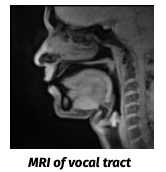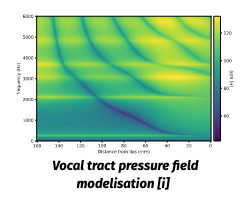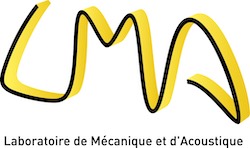Duration : 6 months full-time (between February and August 2023)
Location : Laboratory of Mechanics and Acoustics, Marseille, France
Compensation : Yes, in accordance to the French law (about 600€/month)
Context : The internship offer is part of the ANR-funded RAYOVOX project aiming to develop an intrumentation to characterize all together voice radiation (near and far fields) and vocal tract internal acoustics, this latter being the subject of the present offer. Voice production relies on three major functional stages : 1/ at the thoracic level, air is expelled from the lungs, 2/ within the larynx, a flow-structure instability induce the onset of vocal folds vibration and of sound waves generation, 3/ those waves propagate into the vocal tract whose geometry and acoustical resonances characteristics are controlled by the articulators (jaw, tongue, lips, velum). These resonances shape the spectral content of the radiated pressure, spawning the so-called formants of the voice signal that can be perceived as vowels by the auditory system (from ear to brain). Human oral communication is thus partly based on the control of resonances by the motion of the articulators. These resonances can also be used for artistic purposes in singing, notably in the high soprano range when the sung note can not be controlled by the vocal folds only.
In practice, the frequencies and bandwidths of the vocal tract resonances may be challenging to characterise.
Several methods have been developed, each one having pros and cons. For instance, formant analysis (performed
on audio signals) is only valid for low fundamental frequency ; Magnetic Resonance Imaging is expensive (access
to device, image segmentation) and relies on numerical modelling to derive acoustical properties. A more recent
technique explores directly the acoustical response of the vocal tract to a sound stimulus. A source generating
waves at the lips level and a mere microphone (and some signal processing) offers decent results, with a good
compromise between accuracy and intrusiveness [1].
Vocal tract pressure field
modelisation [i]
 Objectives : The measurement with an excitation located at the lips has already been extensively studied, validating the measurement model (closed
mouth calibration and open mouth measurement, at the same point) and
evidencing its limitations [2]. One of those relates to the poor performances
of the modal analysis of the measured frequency response function (FRF).
In fact, due to the specific placement at the lips of both source and microphone, the FRF exhibits zeros near resonances that affects the modal analysis, particularly for closed vowels (impedance matching case). Numerical
simulations show that microphones placed into the mouth cavity could give
a better resolution and overtake this limitation. Considering their size (few
millimetres), MEMs microphones are a good candidate to be inserted into
dental splint, minimising the inconvenience. Moreover, a set of several microphones would enable a more ro bust Single-Input-Multi-Output (SIMO) modal analysis.
Objectives : The measurement with an excitation located at the lips has already been extensively studied, validating the measurement model (closed
mouth calibration and open mouth measurement, at the same point) and
evidencing its limitations [2]. One of those relates to the poor performances
of the modal analysis of the measured frequency response function (FRF).
In fact, due to the specific placement at the lips of both source and microphone, the FRF exhibits zeros near resonances that affects the modal analysis, particularly for closed vowels (impedance matching case). Numerical
simulations show that microphones placed into the mouth cavity could give
a better resolution and overtake this limitation. Considering their size (few
millimetres), MEMs microphones are a good candidate to be inserted into
dental splint, minimising the inconvenience. Moreover, a set of several microphones would enable a more ro bust Single-Input-Multi-Output (SIMO) modal analysis.
 The intern will focus in :
The intern will focus in :
1. the development of a new experimental setup and its associated model to characterise vocal tract resonances from intraoral microphones response to an external acoustic source at the lips,
2. the adaptation of the modal analysis to retrieve frequency and quality factor data from SIMO acquisitions.
The proposed work outlines are part of a process of development and improvement of a measurement system, both in the theoretical aspect and the experimental implementation.
Master students in acoustics with signal processing knowledge and experimental interest are welcomed to apply.
Key words : Voice acoustics, modal analysis, instrumentation, MEMS.
Bibliography :
[1] Epps et al. Meas. Sci. Tech. 8, 1112-21, 1997.
[2] Maison et al. Proc 16th French Congress on Acoustics, 2022.
More informations about the context, objectives or bibliography, ...



